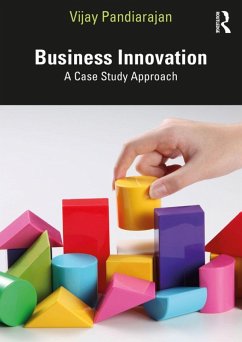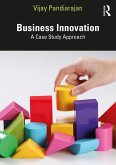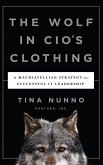

Alle Infos zum eBook verschenken

- Format: PDF
- Merkliste
- Auf die Merkliste
- Bewerten Bewerten
- Teilen
- Produkt teilen
- Produkterinnerung
- Produkterinnerung

Hier können Sie sich einloggen

Bitte loggen Sie sich zunächst in Ihr Kundenkonto ein oder registrieren Sie sich bei bücher.de, um das eBook-Abo tolino select nutzen zu können.
This book provides an understanding of innovation models and why they are important in the business context, and considers sources of innovation and how to apply business frameworks using real-world examples of innovation-led businesses.
After providing a solid background to the key concepts related to innovation models, the book looks at why innovation takes place and where the sources of innovation lie, from corporate research to crowd-sourced and government-funded initiatives. Innovation models across manufacturing, services and government are explored, as well as measuring innovation,…mehr
- Geräte: PC
- mit Kopierschutz
- eBook Hilfe
![Business Innovation (eBook, ePUB) Business Innovation (eBook, ePUB)]() Vijay PandiarajanBusiness Innovation (eBook, ePUB)56,95 €
Vijay PandiarajanBusiness Innovation (eBook, ePUB)56,95 €![Reinventing the C-Suite (eBook, PDF) Reinventing the C-Suite (eBook, PDF)]() Terry WhiteReinventing the C-Suite (eBook, PDF)28,95 €
Terry WhiteReinventing the C-Suite (eBook, PDF)28,95 €![Wolf in Cio's Clothing (eBook, PDF) Wolf in Cio's Clothing (eBook, PDF)]() Tina NunnoWolf in Cio's Clothing (eBook, PDF)24,95 €
Tina NunnoWolf in Cio's Clothing (eBook, PDF)24,95 €![Strategic Management and the Circular Economy (eBook, PDF) Strategic Management and the Circular Economy (eBook, PDF)]() Marcello TonelliStrategic Management and the Circular Economy (eBook, PDF)43,95 €
Marcello TonelliStrategic Management and the Circular Economy (eBook, PDF)43,95 €![Getting from the Bar to the Boardroom (eBook, PDF) Getting from the Bar to the Boardroom (eBook, PDF)]() Doug GentilcoreGetting from the Bar to the Boardroom (eBook, PDF)25,95 €
Doug GentilcoreGetting from the Bar to the Boardroom (eBook, PDF)25,95 €![Handbook of NLP (eBook, PDF) Handbook of NLP (eBook, PDF)]() Harry AlderHandbook of NLP (eBook, PDF)41,95 €
Harry AlderHandbook of NLP (eBook, PDF)41,95 €![Building an Innovation Powerhouse (eBook, PDF) Building an Innovation Powerhouse (eBook, PDF)]() Andy WynnBuilding an Innovation Powerhouse (eBook, PDF)36,95 €
Andy WynnBuilding an Innovation Powerhouse (eBook, PDF)36,95 €-
-
-
After providing a solid background to the key concepts related to innovation models, the book looks at why innovation takes place and where the sources of innovation lie, from corporate research to crowd-sourced and government-funded initiatives. Innovation models across manufacturing, services and government are explored, as well as measuring innovation, and the impact of design thinking and lean enterprise principles on innovation and sustainability-driven imperatives.
Offering a truly comprehensive and global approach, Business Innovation should be core or recommended reading for advanced undergraduate, postgraduate, MBA and Executive Education students studying Innovation Management, Strategic Management and Entrepreneurship.
Dieser Download kann aus rechtlichen Gründen nur mit Rechnungsadresse in A, B, BG, CY, CZ, D, DK, EW, E, FIN, F, GR, HR, H, IRL, I, LT, L, LR, M, NL, PL, P, R, S, SLO, SK ausgeliefert werden.
- Produktdetails
- Verlag: Taylor & Francis eBooks
- Seitenzahl: 356
- Erscheinungstermin: 25. Januar 2022
- Englisch
- ISBN-13: 9781000538182
- Artikelnr.: 63129213
- Verlag: Taylor & Francis eBooks
- Seitenzahl: 356
- Erscheinungstermin: 25. Januar 2022
- Englisch
- ISBN-13: 9781000538182
- Artikelnr.: 63129213
- Herstellerkennzeichnung Die Herstellerinformationen sind derzeit nicht verfügbar.
1. Chapter 1 - Innovation - General Background
1.1 Introduction
1.2 Invention Vs Innovation
1.3 Historical Perspectives of Innovation
1.4 Is innovation limited to Products?
1.5 Innovation in Service
1.6 Concluding Remarks
1.7 References
2. Chapter 2 - Models of Innovation
2.1 Introduction
2.2 Cosmetic/Survival Innovation
2.3 Leap forward Innovation
2.4 Disruptive Innovation
2.4.1 Low-end disruptive innovation
2.4.2 Nascent market disruptive innovation
2.5 Seismic Innovation
2.6 Innovation - What has changed Now?
2.7 Concluding Remarks
2.8 References
3. Chapter 3 - Challenges Embracing Innovation
3.1 Introduction
3.2 Triangular Dilemma
3.3 Market Innovation Challenges
3.3.1 Sticky Customers
3.3.2 Predictable M&A
3.3.3 Stable Supply Chain
3.4 Organizational Innovation Challenges
3.4.1 Lack of Coordinated Innovation Strategy
3.4.2 Lack of Diversity
3.4.3 Compartmentalization
3.4.4 Risk Averse Non-Experimental Culture
3.4.5 Misaligned Incentive
3.4.6 Micromanagement
3.4.7 Span of Control
3.4.8 Lack of Sense of Urgency
3.5 Stakeholder Innovation Challenges
3.5.1 Investor Community
3.5.2 Government
3.5.3 Local Ecosystem
3.5.4 Employees
3.6 Concluding Remarks
3.7. References
Part II - "Why" - Innovation Imperatives
4. Chapter 4 - Innovation - A Key to Business Success
4.1 Introduction
4.2 New Economic Paradigm
4.3 Consumers Are Changing
4.4 Competitive Landscape Changes
4.5 Shorter Product Life Spans
4.6 Globalization Vs Localization
4.7 Digital Tsunami
4.8 Technology Shaping the Business Core
4.9 Dynamic Capabilities
4.10 Concluding Remarks
4.11 References
Part III - "Where" - Sources of Innovation
5. Chapter 5 - Sources of Innovation
5.1 Introduction
5.2 Corporate Research and Development
5.3 Organizational Processes and Ecosystems - Integrated Value Chain
5.4 Corporate Values and Culture
5.5 Partnership and Open Innovation
5.6 Strategic Resources & Talent Architecture
5.7 Operating Model (Governance, KPI, Structure, Accountability etc.)
5.8 Concluding Remarks
5.9 References
Part IV - "How" - Approach to Advance Innovation
6. Chapter 6 - Framework Based Innovation Approach
6.1 Introduction
6.2 Innovation in Action
6.3 Factors Impacting Innovation
6.4 TRIAL© Holistic Framework for Innovation
6.4.1 TRIAL© - Framework Innovation Dimensions
6.4.2 VASTEFA© Leadership Framework
6.5 Concluding Remarks
6.6 References
Part V - Innovations in Industry Verticals
7. Chapter 7 - Innovations in Manufacturing
7.1 Introduction
7.2 Pharmaceuticals
7.3 Heavy Equipment
7.4 Automotive
7.5 Semiconductor
7.6 Concluding Remarks
7.7 References
8. Chapter 8 - Innovations in Service Industry
8.1 Introduction
8.2 Service Trend
8.3 Healthcare
8.4 Retail
8.5 Hospitality
8.6 Education
8.7 Wellness
8.8 Banking
8.9 Transportation
8.10 Concluding Remarks
8.11 References
9. Chapter 9 - Innovations in Government
9.1 Introduction
9.2 Modalities of Community Service - Mass Vs Personalized
9.3 Citizen-Government Redefined Boundaries
9.4 Digital Thread and Realtime Alerts
9.5 Smart Cities
9.6 Concluding Remarks
9.7 References
Part VI - Economics of Innovation
10. Chapter 10 - Measuring Innovation
10.1 Introduction
10.2 Traditional KPIs
10.3 Innovation Risk Vs Reward - A Balanced Approach
10.4 How to Value Innovation - Organic Vs M&A Scenarios
10.5 Concluding Remarks
10.6 References
Part VII - Special Topics on Innovation
11. Chapter 11 - Design Thinking
11.1 Introduction
11.3 Design Thinking for Innovation - Why Now?
11.3 Design Thinking Approach
11.4 Success Stories - Where Design Thinking Advanced Innovation
11.4.1 Airbnb
11.4.2 Ericsson
11.4.3 Burberry
11.4.4 Nordstrom
11.4.5 Bank of America - Keep the Change Program
11.5 Concluding Remarks
11.6 References
12. Chapter 12 - Lean Enterprise and Innovation
12.1 Introduction
12.2 Lean and Innovation- Are they Mutually Exclusive?
12.3 How Lean Accelerates Innovation?
12.4 Success Stories - Where Lean Thinking Advanced Innovation?
12.4.1 Pixar Animation Studios
12.4.2 Dropbox
12.4.3 Zappos
12.4.4 General Electric
12.5 Concluding Remarks
12.6 References
13. Chapter 13 - Sustainability-focused Innovation
13.1 Introduction
13.2 Evolving Market Orientation Towards Sustainability - Gen Z
13.3 Sustainability - A New Secular Growth Driver
13.4 Success Stories - Sustainability Focused Innovation
13.4.1 The Procter & Gamble Company (P&G)
13.4.2 Patagonia
13.4.3 Braskem (Brazil)
13.4.4 Colorifix (UK)
13.5 Concluding Remarks
13.6 References
Part VIII - Case Studies
Case 1: Amgen - Biosimilar Innovations - By Kavya Sivan
Case 2: FedEx: Innovation Through Sustained Adaptability - By Alaina Gregory
Case 3: Reliance Jio: From 4G to Digital Innovation - By Hursh Motwani
Case 4: Stryker Case Study: Design Thinking Response to COVID-19 - By Kyle Geiger
Case 5: Whirlpool - A History of Sustained Innovation from Within - By Malik Abbasi
Case 6: Apple's Swift: A Programming Language Innovation for the Future - By Maxwell Cornellier
Case 7: Microsoft: The Age of Nadella - By Serena Wang and Minnie Sun
Case 8: The Procter & Gamble Company - A Unique Innovation Approach - By Minnie Sun and Serena Wang
Case 9: Timberland - Sustainable Innovation - By Drew Arnson
Case 10: Zara-Inditex - Fast-Fashion Done Right - By Rocco Pelà
Case 11: Patagonia - Leader of a Sustainable Business - By Suzanna Yik
Case 12: Amazon - Head in the Cloud: Transformation Through Leadership's Lens - By William McCrone
Case 13: Ericsson's Innovation through M&A - By Derek Kuo
Case 14: Samsung's New Age Innovation Using Organization and Culture - By Derek Kuo
Case 15: Sun Pharma Industries - Innovation through Specialty acquisition strategy, technology, leadership, and culture - By Katie Kuhlman
Case 16: Ecovative Design - Sustainable Business - By Daniel Meeks
1. Chapter 1 - Innovation - General Background
1.1 Introduction
1.2 Invention Vs Innovation
1.3 Historical Perspectives of Innovation
1.4 Is innovation limited to Products?
1.5 Innovation in Service
1.6 Concluding Remarks
1.7 References
2. Chapter 2 - Models of Innovation
2.1 Introduction
2.2 Cosmetic/Survival Innovation
2.3 Leap forward Innovation
2.4 Disruptive Innovation
2.4.1 Low-end disruptive innovation
2.4.2 Nascent market disruptive innovation
2.5 Seismic Innovation
2.6 Innovation - What has changed Now?
2.7 Concluding Remarks
2.8 References
3. Chapter 3 - Challenges Embracing Innovation
3.1 Introduction
3.2 Triangular Dilemma
3.3 Market Innovation Challenges
3.3.1 Sticky Customers
3.3.2 Predictable M&A
3.3.3 Stable Supply Chain
3.4 Organizational Innovation Challenges
3.4.1 Lack of Coordinated Innovation Strategy
3.4.2 Lack of Diversity
3.4.3 Compartmentalization
3.4.4 Risk Averse Non-Experimental Culture
3.4.5 Misaligned Incentive
3.4.6 Micromanagement
3.4.7 Span of Control
3.4.8 Lack of Sense of Urgency
3.5 Stakeholder Innovation Challenges
3.5.1 Investor Community
3.5.2 Government
3.5.3 Local Ecosystem
3.5.4 Employees
3.6 Concluding Remarks
3.7. References
Part II - "Why" - Innovation Imperatives
4. Chapter 4 - Innovation - A Key to Business Success
4.1 Introduction
4.2 New Economic Paradigm
4.3 Consumers Are Changing
4.4 Competitive Landscape Changes
4.5 Shorter Product Life Spans
4.6 Globalization Vs Localization
4.7 Digital Tsunami
4.8 Technology Shaping the Business Core
4.9 Dynamic Capabilities
4.10 Concluding Remarks
4.11 References
Part III - "Where" - Sources of Innovation
5. Chapter 5 - Sources of Innovation
5.1 Introduction
5.2 Corporate Research and Development
5.3 Organizational Processes and Ecosystems - Integrated Value Chain
5.4 Corporate Values and Culture
5.5 Partnership and Open Innovation
5.6 Strategic Resources & Talent Architecture
5.7 Operating Model (Governance, KPI, Structure, Accountability etc.)
5.8 Concluding Remarks
5.9 References
Part IV - "How" - Approach to Advance Innovation
6. Chapter 6 - Framework Based Innovation Approach
6.1 Introduction
6.2 Innovation in Action
6.3 Factors Impacting Innovation
6.4 TRIAL(c) Holistic Framework for Innovation
6.4.1 TRIAL(c) - Framework Innovation Dimensions
6.4.2 VASTEFA(c) Leadership Framework
6.5 Concluding Remarks
6.6 References
Part V - Innovations in Industry Verticals
7. Chapter 7 - Innovations in Manufacturing
7.1 Introduction
7.2 Pharmaceuticals
7.3 Heavy Equipment
7.4 Automotive
7.5 Semiconductor
7.6 Concluding Remarks
7.7 References
8. Chapter 8 - Innovations in Service Industry
8.1 Introduction
8.2 Service Trend
8.3 Healthcare
8.4 Retail
8.5 Hospitality
8.6 Education
8.7 Wellness
8.8 Banking
8.9 Transportation
8.10 Concluding Remarks
8.11 References
9. Chapter 9 - Innovations in Government
9.1 Introduction
9.2 Modalities of Community Service - Mass Vs Personalized
9.3 Citizen-Government Redefined Boundaries
9.4 Digital Thread and Realtime Alerts
9.5 Smart Cities
9.6 Concluding Remarks
9.7 References
Part VI - Economics of Innovation
10. Chapter 10 - Measuring Innovation
10.1 Introduction
10.2 Traditional KPIs
10.3 Innovation Risk Vs Reward - A Balanced Approach
10.4 How to Value Innovation - Organic Vs M&A Scenarios
10.5 Concluding Remarks
10.6 References
Part VII - Special Topics on Innovation
11. Chapter 11 - Design Thinking
11.1 Introduction
11.3 Design Thinking for Innovation - Why Now?
11.3 Design Thinking Approach
11.4 Success Stories - Where Design Thinking Advanced Innovation
11.4.1 Airbnb
11.4.2 Ericsson
11.4.3 Burberry
11.4.4 Nordstrom
11.4.5 Bank of America - Keep the Change Program
11.5 Concluding Remarks
11.6 References
12. Chapter 12 - Lean Enterprise and Innovation
12.1 Introduction
12.2 Lean and Innovation- Are they Mutually Exclusive?
12.3 How Lean Accelerates Innovation?
12.4 Success Stories - Where Lean Thinking Advanced Innovation?
12.4.1 Pixar Animation Studios
12.4.2 Dropbox
12.4.3 Zappos
12.4.4 General Electric
12.5 Concluding Remarks
12.6 References
13. Chapter 13 - Sustainability-focused Innovation
13.1 Introduction
13.2 Evolving Market Orientation Towards Sustainability - Gen Z
13.3 Sustainability - A New Secular Growth Driver
13.4 Success Stories - Sustainability Focused Innovation
13.4.1 The Procter & Gamble Company (P&G)
13.4.2 Patagonia
13.4.3 Braskem (Brazil)
13.4.4 Colorifix (UK)
13.5 Concluding Remarks
13.6 References
Part VIII - Case Studies
Case 1: Amgen - Biosimilar Innovations - By Kavya Sivan
Case 2: FedEx: Innovation Through Sustained Adaptability - By Alaina
Gregory
Case 3: Reliance Jio: From 4G to Digital Innovation - By Hursh Motwani
Case 4: Stryker Case Study: Design Thinking Response to COVID-19 - By Kyle
Geiger
Case 5: Whirlpool - A History of Sustained Innovation from Within - By
Malik Abbasi
Case 6: Apple's Swift: A Programming Language Innovation for the Future -
By Maxwell Cornellier
Case 7: Microsoft: The Age of Nadella - By Serena Wang and Minnie Sun
Case 8: The Procter & Gamble Company - A Unique Innovation Approach - By
Minnie Sun and Serena Wang
Case 9: Timberland - Sustainable Innovation - By Drew Arnson
Case 10: Zara-Inditex - Fast-Fashion Done Right - By Rocco Pelà
Case 11: Patagonia - Leader of a Sustainable Business - By Suzanna Yik
Case 12: Amazon - Head in the Cloud: Transformation Through Leadership's
Lens - By William McCrone
Case 13: Ericsson's Innovation through M&A - By Derek Kuo
Case 14: Samsung's New Age Innovation Using Organization and Culture - By
Derek Kuo
Case 15: Sun Pharma Industries - Innovation through Specialty acquisition
strategy, technology, leadership, and culture - By Katie Kuhlman
Case 16: Ecovative Design - Sustainable Business - By Daniel Meeks
1. Chapter 1 - Innovation - General Background
1.1 Introduction
1.2 Invention Vs Innovation
1.3 Historical Perspectives of Innovation
1.4 Is innovation limited to Products?
1.5 Innovation in Service
1.6 Concluding Remarks
1.7 References
2. Chapter 2 - Models of Innovation
2.1 Introduction
2.2 Cosmetic/Survival Innovation
2.3 Leap forward Innovation
2.4 Disruptive Innovation
2.4.1 Low-end disruptive innovation
2.4.2 Nascent market disruptive innovation
2.5 Seismic Innovation
2.6 Innovation - What has changed Now?
2.7 Concluding Remarks
2.8 References
3. Chapter 3 - Challenges Embracing Innovation
3.1 Introduction
3.2 Triangular Dilemma
3.3 Market Innovation Challenges
3.3.1 Sticky Customers
3.3.2 Predictable M&A
3.3.3 Stable Supply Chain
3.4 Organizational Innovation Challenges
3.4.1 Lack of Coordinated Innovation Strategy
3.4.2 Lack of Diversity
3.4.3 Compartmentalization
3.4.4 Risk Averse Non-Experimental Culture
3.4.5 Misaligned Incentive
3.4.6 Micromanagement
3.4.7 Span of Control
3.4.8 Lack of Sense of Urgency
3.5 Stakeholder Innovation Challenges
3.5.1 Investor Community
3.5.2 Government
3.5.3 Local Ecosystem
3.5.4 Employees
3.6 Concluding Remarks
3.7. References
Part II - "Why" - Innovation Imperatives
4. Chapter 4 - Innovation - A Key to Business Success
4.1 Introduction
4.2 New Economic Paradigm
4.3 Consumers Are Changing
4.4 Competitive Landscape Changes
4.5 Shorter Product Life Spans
4.6 Globalization Vs Localization
4.7 Digital Tsunami
4.8 Technology Shaping the Business Core
4.9 Dynamic Capabilities
4.10 Concluding Remarks
4.11 References
Part III - "Where" - Sources of Innovation
5. Chapter 5 - Sources of Innovation
5.1 Introduction
5.2 Corporate Research and Development
5.3 Organizational Processes and Ecosystems - Integrated Value Chain
5.4 Corporate Values and Culture
5.5 Partnership and Open Innovation
5.6 Strategic Resources & Talent Architecture
5.7 Operating Model (Governance, KPI, Structure, Accountability etc.)
5.8 Concluding Remarks
5.9 References
Part IV - "How" - Approach to Advance Innovation
6. Chapter 6 - Framework Based Innovation Approach
6.1 Introduction
6.2 Innovation in Action
6.3 Factors Impacting Innovation
6.4 TRIAL© Holistic Framework for Innovation
6.4.1 TRIAL© - Framework Innovation Dimensions
6.4.2 VASTEFA© Leadership Framework
6.5 Concluding Remarks
6.6 References
Part V - Innovations in Industry Verticals
7. Chapter 7 - Innovations in Manufacturing
7.1 Introduction
7.2 Pharmaceuticals
7.3 Heavy Equipment
7.4 Automotive
7.5 Semiconductor
7.6 Concluding Remarks
7.7 References
8. Chapter 8 - Innovations in Service Industry
8.1 Introduction
8.2 Service Trend
8.3 Healthcare
8.4 Retail
8.5 Hospitality
8.6 Education
8.7 Wellness
8.8 Banking
8.9 Transportation
8.10 Concluding Remarks
8.11 References
9. Chapter 9 - Innovations in Government
9.1 Introduction
9.2 Modalities of Community Service - Mass Vs Personalized
9.3 Citizen-Government Redefined Boundaries
9.4 Digital Thread and Realtime Alerts
9.5 Smart Cities
9.6 Concluding Remarks
9.7 References
Part VI - Economics of Innovation
10. Chapter 10 - Measuring Innovation
10.1 Introduction
10.2 Traditional KPIs
10.3 Innovation Risk Vs Reward - A Balanced Approach
10.4 How to Value Innovation - Organic Vs M&A Scenarios
10.5 Concluding Remarks
10.6 References
Part VII - Special Topics on Innovation
11. Chapter 11 - Design Thinking
11.1 Introduction
11.3 Design Thinking for Innovation - Why Now?
11.3 Design Thinking Approach
11.4 Success Stories - Where Design Thinking Advanced Innovation
11.4.1 Airbnb
11.4.2 Ericsson
11.4.3 Burberry
11.4.4 Nordstrom
11.4.5 Bank of America - Keep the Change Program
11.5 Concluding Remarks
11.6 References
12. Chapter 12 - Lean Enterprise and Innovation
12.1 Introduction
12.2 Lean and Innovation- Are they Mutually Exclusive?
12.3 How Lean Accelerates Innovation?
12.4 Success Stories - Where Lean Thinking Advanced Innovation?
12.4.1 Pixar Animation Studios
12.4.2 Dropbox
12.4.3 Zappos
12.4.4 General Electric
12.5 Concluding Remarks
12.6 References
13. Chapter 13 - Sustainability-focused Innovation
13.1 Introduction
13.2 Evolving Market Orientation Towards Sustainability - Gen Z
13.3 Sustainability - A New Secular Growth Driver
13.4 Success Stories - Sustainability Focused Innovation
13.4.1 The Procter & Gamble Company (P&G)
13.4.2 Patagonia
13.4.3 Braskem (Brazil)
13.4.4 Colorifix (UK)
13.5 Concluding Remarks
13.6 References
Part VIII - Case Studies
Case 1: Amgen - Biosimilar Innovations - By Kavya Sivan
Case 2: FedEx: Innovation Through Sustained Adaptability - By Alaina Gregory
Case 3: Reliance Jio: From 4G to Digital Innovation - By Hursh Motwani
Case 4: Stryker Case Study: Design Thinking Response to COVID-19 - By Kyle Geiger
Case 5: Whirlpool - A History of Sustained Innovation from Within - By Malik Abbasi
Case 6: Apple's Swift: A Programming Language Innovation for the Future - By Maxwell Cornellier
Case 7: Microsoft: The Age of Nadella - By Serena Wang and Minnie Sun
Case 8: The Procter & Gamble Company - A Unique Innovation Approach - By Minnie Sun and Serena Wang
Case 9: Timberland - Sustainable Innovation - By Drew Arnson
Case 10: Zara-Inditex - Fast-Fashion Done Right - By Rocco Pelà
Case 11: Patagonia - Leader of a Sustainable Business - By Suzanna Yik
Case 12: Amazon - Head in the Cloud: Transformation Through Leadership's Lens - By William McCrone
Case 13: Ericsson's Innovation through M&A - By Derek Kuo
Case 14: Samsung's New Age Innovation Using Organization and Culture - By Derek Kuo
Case 15: Sun Pharma Industries - Innovation through Specialty acquisition strategy, technology, leadership, and culture - By Katie Kuhlman
Case 16: Ecovative Design - Sustainable Business - By Daniel Meeks
1. Chapter 1 - Innovation - General Background
1.1 Introduction
1.2 Invention Vs Innovation
1.3 Historical Perspectives of Innovation
1.4 Is innovation limited to Products?
1.5 Innovation in Service
1.6 Concluding Remarks
1.7 References
2. Chapter 2 - Models of Innovation
2.1 Introduction
2.2 Cosmetic/Survival Innovation
2.3 Leap forward Innovation
2.4 Disruptive Innovation
2.4.1 Low-end disruptive innovation
2.4.2 Nascent market disruptive innovation
2.5 Seismic Innovation
2.6 Innovation - What has changed Now?
2.7 Concluding Remarks
2.8 References
3. Chapter 3 - Challenges Embracing Innovation
3.1 Introduction
3.2 Triangular Dilemma
3.3 Market Innovation Challenges
3.3.1 Sticky Customers
3.3.2 Predictable M&A
3.3.3 Stable Supply Chain
3.4 Organizational Innovation Challenges
3.4.1 Lack of Coordinated Innovation Strategy
3.4.2 Lack of Diversity
3.4.3 Compartmentalization
3.4.4 Risk Averse Non-Experimental Culture
3.4.5 Misaligned Incentive
3.4.6 Micromanagement
3.4.7 Span of Control
3.4.8 Lack of Sense of Urgency
3.5 Stakeholder Innovation Challenges
3.5.1 Investor Community
3.5.2 Government
3.5.3 Local Ecosystem
3.5.4 Employees
3.6 Concluding Remarks
3.7. References
Part II - "Why" - Innovation Imperatives
4. Chapter 4 - Innovation - A Key to Business Success
4.1 Introduction
4.2 New Economic Paradigm
4.3 Consumers Are Changing
4.4 Competitive Landscape Changes
4.5 Shorter Product Life Spans
4.6 Globalization Vs Localization
4.7 Digital Tsunami
4.8 Technology Shaping the Business Core
4.9 Dynamic Capabilities
4.10 Concluding Remarks
4.11 References
Part III - "Where" - Sources of Innovation
5. Chapter 5 - Sources of Innovation
5.1 Introduction
5.2 Corporate Research and Development
5.3 Organizational Processes and Ecosystems - Integrated Value Chain
5.4 Corporate Values and Culture
5.5 Partnership and Open Innovation
5.6 Strategic Resources & Talent Architecture
5.7 Operating Model (Governance, KPI, Structure, Accountability etc.)
5.8 Concluding Remarks
5.9 References
Part IV - "How" - Approach to Advance Innovation
6. Chapter 6 - Framework Based Innovation Approach
6.1 Introduction
6.2 Innovation in Action
6.3 Factors Impacting Innovation
6.4 TRIAL(c) Holistic Framework for Innovation
6.4.1 TRIAL(c) - Framework Innovation Dimensions
6.4.2 VASTEFA(c) Leadership Framework
6.5 Concluding Remarks
6.6 References
Part V - Innovations in Industry Verticals
7. Chapter 7 - Innovations in Manufacturing
7.1 Introduction
7.2 Pharmaceuticals
7.3 Heavy Equipment
7.4 Automotive
7.5 Semiconductor
7.6 Concluding Remarks
7.7 References
8. Chapter 8 - Innovations in Service Industry
8.1 Introduction
8.2 Service Trend
8.3 Healthcare
8.4 Retail
8.5 Hospitality
8.6 Education
8.7 Wellness
8.8 Banking
8.9 Transportation
8.10 Concluding Remarks
8.11 References
9. Chapter 9 - Innovations in Government
9.1 Introduction
9.2 Modalities of Community Service - Mass Vs Personalized
9.3 Citizen-Government Redefined Boundaries
9.4 Digital Thread and Realtime Alerts
9.5 Smart Cities
9.6 Concluding Remarks
9.7 References
Part VI - Economics of Innovation
10. Chapter 10 - Measuring Innovation
10.1 Introduction
10.2 Traditional KPIs
10.3 Innovation Risk Vs Reward - A Balanced Approach
10.4 How to Value Innovation - Organic Vs M&A Scenarios
10.5 Concluding Remarks
10.6 References
Part VII - Special Topics on Innovation
11. Chapter 11 - Design Thinking
11.1 Introduction
11.3 Design Thinking for Innovation - Why Now?
11.3 Design Thinking Approach
11.4 Success Stories - Where Design Thinking Advanced Innovation
11.4.1 Airbnb
11.4.2 Ericsson
11.4.3 Burberry
11.4.4 Nordstrom
11.4.5 Bank of America - Keep the Change Program
11.5 Concluding Remarks
11.6 References
12. Chapter 12 - Lean Enterprise and Innovation
12.1 Introduction
12.2 Lean and Innovation- Are they Mutually Exclusive?
12.3 How Lean Accelerates Innovation?
12.4 Success Stories - Where Lean Thinking Advanced Innovation?
12.4.1 Pixar Animation Studios
12.4.2 Dropbox
12.4.3 Zappos
12.4.4 General Electric
12.5 Concluding Remarks
12.6 References
13. Chapter 13 - Sustainability-focused Innovation
13.1 Introduction
13.2 Evolving Market Orientation Towards Sustainability - Gen Z
13.3 Sustainability - A New Secular Growth Driver
13.4 Success Stories - Sustainability Focused Innovation
13.4.1 The Procter & Gamble Company (P&G)
13.4.2 Patagonia
13.4.3 Braskem (Brazil)
13.4.4 Colorifix (UK)
13.5 Concluding Remarks
13.6 References
Part VIII - Case Studies
Case 1: Amgen - Biosimilar Innovations - By Kavya Sivan
Case 2: FedEx: Innovation Through Sustained Adaptability - By Alaina
Gregory
Case 3: Reliance Jio: From 4G to Digital Innovation - By Hursh Motwani
Case 4: Stryker Case Study: Design Thinking Response to COVID-19 - By Kyle
Geiger
Case 5: Whirlpool - A History of Sustained Innovation from Within - By
Malik Abbasi
Case 6: Apple's Swift: A Programming Language Innovation for the Future -
By Maxwell Cornellier
Case 7: Microsoft: The Age of Nadella - By Serena Wang and Minnie Sun
Case 8: The Procter & Gamble Company - A Unique Innovation Approach - By
Minnie Sun and Serena Wang
Case 9: Timberland - Sustainable Innovation - By Drew Arnson
Case 10: Zara-Inditex - Fast-Fashion Done Right - By Rocco Pelà
Case 11: Patagonia - Leader of a Sustainable Business - By Suzanna Yik
Case 12: Amazon - Head in the Cloud: Transformation Through Leadership's
Lens - By William McCrone
Case 13: Ericsson's Innovation through M&A - By Derek Kuo
Case 14: Samsung's New Age Innovation Using Organization and Culture - By
Derek Kuo
Case 15: Sun Pharma Industries - Innovation through Specialty acquisition
strategy, technology, leadership, and culture - By Katie Kuhlman
Case 16: Ecovative Design - Sustainable Business - By Daniel Meeks
- Thomas H. Davenport, Distinguished Professor of IT and Management, Babson College, Visiting Professor, Oxford University Saïd Business School, Senior Advisor, Deloitte Analytics and AI Practice, Digital Fellow, MIT Initiative on the Digital Economy
"This book is a great introduction to innovation that is unique in its approach with numerous case studies and examples representing leading global corporations. It integrates some of the important topics such as design thinking, lean start-up, and sustainability which I think are very relevant to the topic of Innovation. Student activities at the end of each chapter leveraging attached cases will reinforce learning of the concepts, tools, and frameworks discussed. Well researched and timely publication written by an experienced author, and I am sure students and practitioners will find it very useful."
- Pierre Azoulay, Professor, Technological Innovation, Entrepreneurship, and Strategic Management, MIT Sloan School of Management, USA
"This Innovation textbook by Vijay Pandiarajan approaches innovation in a systematic way by explaining concepts and frameworks thoroughly with real-world examples and cases studies. I particularly enjoyed its ability to address innovation trends in many industry verticals and discuss lean, design thinking, and sustainability imperatives. This book will certainly benefit undergraduate and graduate students as well as innovation practitioners from the industry."
- Feng Zhu, Professor of Business Administration, Technology and Operations, Harvard Business School, USA
"It's exciting to see Vijay launch his book [Business Innovation: A Case Study Approach] for both students and innovation practitioners. The storytelling approach to formally introduce Innovation with frameworks to address key idea of 'how to advance innovation " is powerful. This can be a one-stop source for those who want to get formally introduced to and for practice of innovation processes."
- Martin J. Curran, Executive Vice President, Corning Innovation Officer, USA







